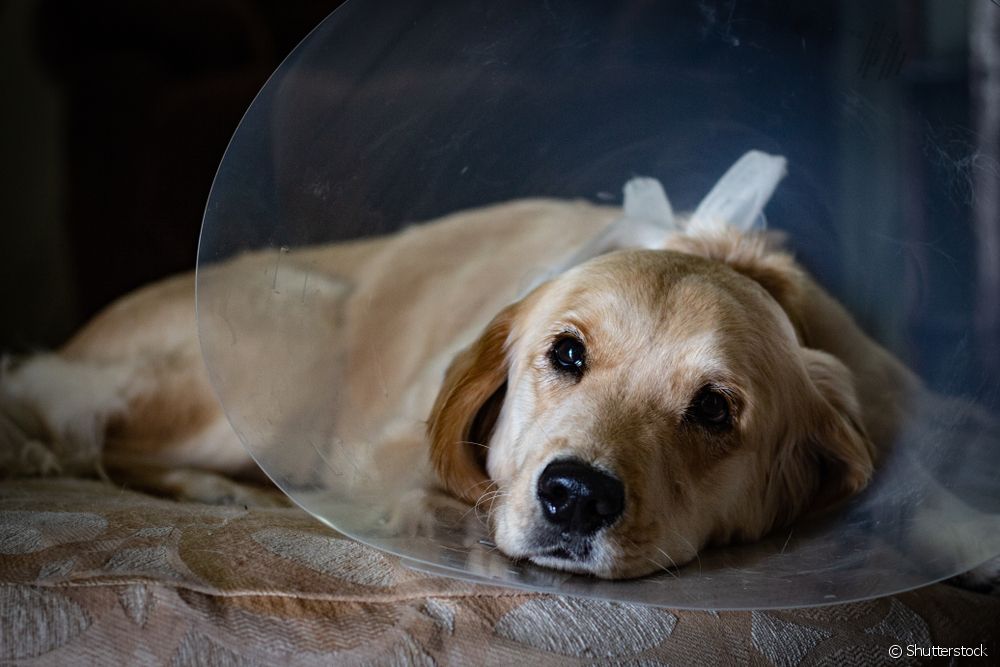Dog castration surgery: everything you need to know about dog sterilization

Table of contents
Dog castration still causes concern in many owners - especially first-time ones. The tension is due to the fact that many believe that the procedure can pose risks to the pet's life; but, in fact, the surgery brings many benefits when released by the veterinarian and can even make the animal have an even higher life expectancy! But, as we know well thatall care is little when it comes to the four-legged friend, we have prepared a special article to clarify the main doubts on the subject. Do you want to know what to expect from castration; the differences of female castration surgery; how to take care of the castrated dog; and more? Stay here and check it out!
Is neutering a dog really necessary? Understand the benefits:
Among the myths related to dog castration, the one that most worries pet parents is the possibility of the animal's life being at risk. But, if there is proper preoperative monitoring by the veterinarian and the place chosen for surgery is reliable, there is no need to worry - and the procedure will still offer many benefits to the dog's health!
One of the main advantages of castrating a male dog is the prevention of prostate cancer, testicular cancer and infections that may appear in the genital organ. In addition, the animal no longer needs to mark territory with pee - which makes walks on the street much more peaceful for the owner and reduces the chance of urine appearing in random places in the house. Dog castrationfemale, in turn, avoids unwanted pregnancy - which even helps to reduce the number of street dogs - and psychological pregnancy that can cause the dreaded breast infection. And it doesn't stop there: it also prevents pyometra in bitches (a uterine disorder that affects dogs and cats); the development of cancer in the mammary glands and, also, the transmission of genetically modified diseases.communicable diseases - such as epilepsy and dysplasia.
But, when making the decision to have dog or bitch castration surgery, it is very important to consult the veterinarian who accompanies the animal to confirm that the puppy is really able to go through anesthesia and the entire procedure without any risk. And as much as it is common for surgery to be done before the first heat of females and right after the first heat of the year.first vaccination cycle for males, it is also he who should inform you of the ideal age to castrate your dog - especially if you have only begun to understand the importance of castration with your four-legged friend already in adulthood.
Where to have dog castration surgery?
After the veterinarian's release, it is necessary to look for a reliable clinic so that the procedure is done as safely as possible! And how much does it cost to castrate a dog? The value may vary from region to region, but female dog castration surgery can reach R$1000, while, in males, the average is between R$500 and R$700.
However, those who are not in a position to afford the financial costs need to give up on dog castration surgery: the good news is that there are specific - and reliable! - sterilization campaigns that offer the service for free or at popular prices, in addition to colleges with veterinary courses that also do the procedure for a lower cost. The tip is to get informedabout the projects in your city and see the best option together with the veterinarian who accompanies the pet.

Male dog castration surgery vs female dog castration: how the procedure works in each case:
Both dogs and bitches need to be fasting before castration: 6 hours without water and 12 hours without food, in general. But the procedure itself is done in different ways in both - and, as you might expect from the higher average values, it is more laborious and invasive in females. In them, the most common type is called ovariectomy, and it surgically removes the uterus and ovaries.Because it is an internal surgery, it takes longer and also requires a longer recovery time in the postoperative period (which, in general, is usually from one week to twelve days). It is common for the male dog to be released on the same day, while females need to be observed for 24 hours so that possible bleeding and changes in the blood pressure can be contained.pressure.
Male dog castration, on the other hand, is called orchiectomy and is performed by removing both testicles. External, it is much simpler than that of females and, in general, has a faster recovery. A common concern of owners is about how the castrated dog's sac looks after the procedure - and the answer is that it can vary according to how the surgery was done. The mostIt is common for vets to just close the skin with two or three stitches after the testicle has been removed, and when this is the case, the area is left intact, just without the testicles inside. When doctors prefer to remove the skin completely, the site that was the testicles is almost imperceptible after a few years.
Necessary care in the postoperative period of dog castration:
To ensure a good recovery after the surgery, some care must be taken in the post-operative process of dog castration. It is important, for example, to provide an Elizabethan collar for males and a surgical garment for females to prevent them from licking or biting the area of the stitches and hindering the healing process. Depending on how the pain is, the veterinarian will eithermay also prescribe painkillers and anti-inflammatories in the first week.
The suture should also be cleaned every day - and, as with everything involving castration surgery, the vet should be consulted to inform you of the best way to go about the procedure. However, if you already want to get an idea of how to bandage a neutered dog, the step-by-step is usually as follows:
See_also: Banana oatmeal dog treat: recipe with only 4 ingredients1 - Try to get the dog relaxed and in the most comfortable position possible;
2 - Start by cleaning the area with the antiseptic recommended by the veterinarian;
3 - Use gauze to dry the area. It is common to think of using cotton, but it is not the most suitable because it can end up loosening some threads that will only hinder healing;
4 - Once this is done, if the veterinarian has indicated any ointment or medicine, it is time to apply it;
5 - To finish, cover the area with a clean gauze and secure with adhesive plaster or a bandage.
In addition, it is worth remembering that it is very important to prevent the pet from making efforts and to rest until it is fully recovered. Even leave the food and water as close as possible so that he does not have to make efforts to reach them. In addition, if you notice any changes in the healing area or in the dog's health, be sure to seek veterinary adviceimmediately.
See_also: Vitamin for dogs: when to use it?
How long can you bathe a neutered dog?
As the dressing needs to be cleaned and changed daily, as well as exposure should be avoided, the ideal is not to bathe the castrated dog during this period. The recommendation is to wait for the removal of the stitches - which, in general, usually takes place 60 days after surgery. But, after that time, you still need to be careful when bathing the pet, okay? No rubbing the region where the incision was made.made.
Does the animal's behavior change after surgery?
Much is said about how the dog changes after castration, but after all, the pet is calmer after surgery? The statement is not even a myth. This is because castration alters the production of hormones that are directly linked to the way the pet behaves - as is the case with testosterone, for example.
Because of this, in addition to the male no longer having the need to mark territory with pee, in general, aggression and irritation also tend to decrease in both sexes. You just can't say that calmness in the neutered dog is a general rule because, if the aggressive behavior is not related to the production of sex hormones, or if the animal has already had surgery in adulthood or old age, nothere will be no significant change.
But you may be wondering: in cases where the pet's agitated behavior is really related to hormones, how long after castration does the dog become calmer? The answer is that you can't say for sure. The time required for the change in behavior may vary, but it is certain that the change is not immediate. After the procedure, there are still many hormones in the body.dog's blood - which requires a certain amount of time for the temperamental change to really happen.
Another possible consequence of the change in hormones is the increase in weight of the castrated dog. But with nutritional monitoring by the veterinarian and the practice of physical exercises when the pet is fully recovered can reverse the problem.

